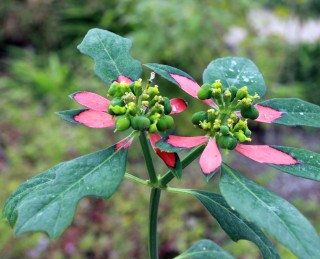
Wild poinsettia is a colorful native plant. It is a close cousin to the Christmas Poinsettia that originated in central Mexico. Both species develop red “leaves” (these are called bracts) near the top of the plants. The actual flowers are small, yellow-and-green structures at the center of the bracts. Look closely at the flowers and you will see that each consists of a green cup, about a quarter of an inch across, with a single stamen and a single pistil. A pair of yellow, lip-like glands adorns the side of the cup. Robert Benson photo.
“Why are you pulling that plant up?” My husband asked. I handed the foot-tall plant to him.
“It’s a weed. It comes up all around the garden. I don’t like it much.” I replied.
“But it is kind of pretty with these red petals…” he said, pointing to the top of the plant.
“Those aren’t real petals; they are leaves that color up. The real flowers are these little greenish-yellow things here in the center. This plant is a wild poinsettia.”
“What? A wild poinsettia? Is it the source of all these Christmas poinsettias we are seeing in the stores right now?” he questioned.
“Well, maybe not the exact species that the showy poinsettias come from…but it is in the same genus. I think that Christmas poinsettias came originally from central Mexico. Don’t you know anything about poinsettias?” I complained.
“I know that poinsettias are big business this time of year. So tell me all you know about them…”
Oops. What else could I say for sure about these plants? It was time to do some research.
The first thing we found out was that our wild poinsettia’s scientific name is Euphorbia cyathophora. “Cyathophora” means “cup-bearer” and it refers to the shape of the small flowers all these spurges (Euphorbias) produce. The Mexican plant that became the hugely popular holiday poinsettia is Euphorbia pulcherrima. Its name means “the most beautiful Euphorbia.” But, how did it get the name ‘poinsettia’ we wondered. Again we trolled the Internet.
It turns out that he first US ambassador to Mexico was named Joel Roberts Poinsett. He was an avid amateur botanist as well as a diplomat. He was fascinated with the bright red flowering plants that bloomed right about Christmas time in Mexico City. In 1828, Poinsett introduced the plants to the United States and the poinsettia was born.
I imagine the first plants did not do so well. For one thing, they are frost sensitive. Even if protected from freezing, poinsettias won’t bloom unless they have specific periods of bright light and total darkness.
This is called photoperiodism. To bloom, E. pulcherrima needs nights that are 12 hours long for at least five nights in a row. And it must be completely dark. The weak light of a street lamp or even a light leak under a door can prevent the poinsettia bracts from coloring up properly. Growers had to learn how to cover their plants with boxes or black plastic tunnels for the required hours of nighttime.
Then they had to uncover them so they could have plenty of light in the daytime in order to grow into healthy, compact plants. In nature, however, the poinsettia is a rather lanky plant with long stems to four feet and not very many leaves. To get the compact balls of color we see in our modern holiday poinsettias, growers had to “pinch” back the tips of the stems, sometimes several times during the growing season. In the 1900s, horticulturists learned to apply a chemical growth retardant at precise times to prevent the stems from elongating. Some successful poinsettia growers also developed grafting methods that produced a fuller plant.
What really made poinsettias the “must have” Christmas plant was marketing. Paul Ecke and his son, Paul Ecke Jr., began distributing their beautifully grown poinsettias to television stations during the holiday season in the 1950s. Soon the connection of poinsettias to Christmas was well established. Demand was high. But the Ecke Ranch in California enjoyed a near monopoly on the business until 1990.
Nowadays, the supply of poinsettias is great. Much of the growing is now done in Central America. And there are some incredibly lovely cultivars available. I am sure you have seen white poinsettias and pink ones and even marbled looking ones. Buy, enjoy, and grow these plants. You may even get them to rebloom for you.
But don’t forget the humble little wild poinsettia. It is found in most of the United States. It likes moist soil and good light, so it may be “volunteering” in your flower beds. A wild poinsettia coming up in your snapdragons may look like a weed, but if you can get a mass of them growing together, the result is quite attractive.
Maybe E. cyathophora just needs a new name. Some wild plant guides call it Painted Leaf and Fire-on-the-Mountain. A bed of Fire-on-the-Mountain sounds so exotic! I am going to be the first naturalist to popularize this hardy little weed!
ESSAY BY KAREN L. P. BENSON
If you would like to receive Karen’s Nature Essays by email, please signup here.
